Many of Granville County’s Native American families came to the county from Virginia to escape the intrusions of the British colonists. The Bass, Evans, and Anderson families are just several examples of coastal Algonquian speaking peoples that followed this route. The Kersey family is no exception, and has roots in Surry County, VA among the Weyanoke, an Algonquian speaking people who allied and moved in with Nottoway and Tuscarora on their reservations. In this blog post I will trace the Kersey family from the Surry Co, VA area to Granville Co, NC.
Lumbee scholar J. Cedric Woods published an essay titled, “Lumbee Origins: The Weyanoke-Kersey Connection” in support of the Lumbee Tribe’s federal recognition bid. The full text of the essay can be found here and here (pdf format). The tribal origins of the Kersey family are relevant to the Lumbees because the tribe’s Lowry/Lowrie family of Robeson County, NC descend from the Kersey family – specifically a Sally Kersey who was described as a “half-breed Tuscarora woman” during the Civil War era. Sally Kersey was the grandmother of famed Tuscarora (later Lumbee) hero Henry Berry Lowrie/Lowry (1845-1872). Through careful examination of genealogical and historical records, Woods chronicles how a Weyanoke man named Thomas Kersey (born 1665) from Surry Co,VA resettled close to the Tuscarora “Indian Woods” reservation in Bertie Co, NC. His Kersey family likely intermarried with the Tuscarora before moving down together to Robeson Co. I will be citing Wood’s scholarship for this article as well as Paul Heinegg’s genealogy of the Kersey family.
Who are the Weyanoke?
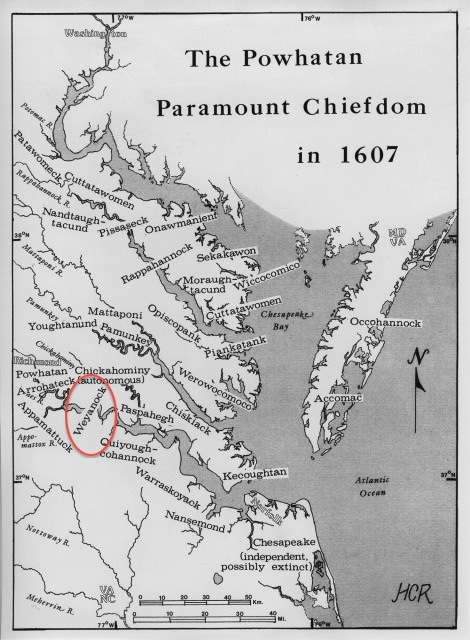
Source: Helen Rountree
The Weyanoke are an Algonquian-speaking tribe of the Powhatan Confederacy from the Tidewater area of Virginia. Because of ongoing conflicts between indigenous people and the British colony, the Weyanoke moved around quite a bit to seek shelter, and by the 18th century had integrated onto the Nottoway and Tuscarora reservations. The surname “Wineoak” appears on the land records for both reservations, indicating that these community members were of Weyanoke descent. Cedric Woods describes this movement and integration of tribal people:
As this case study will show, what may be initially viewed as a spin-off of what I maintain as a Weyanoke individual, was actually the continuation of a cross border movement to friendlier social and political environs. These person also did not move in isolated fashion. They are individual faces of historic movements of tribes. Additionally, they did not move to isolation, but maintained contact with their kinsfolks and allies, and recreated their communities as much as possible in new territory. This process created new Native communities in North Carolina with very ancient roots in Virginia.
What Woods is describing is exactly what I’ve noticed in carefully describing the genealogies of Granville’s Native American families. These families moved together from one location to the next, and along the way brought in allied Native families to sustain their Native identity. This is why these families are so interrelated across state and county borders because of centuries of documented intermarriage. For the Weyanoke families that moved out of Virginia and into North Carolina, they did not simply “blend” into African-American or European-American communities like researcher Heinegg suggests, but rather they moved together with other Native American families to form new tribal communities.
Cedric Woods also points to another trend that lead to the “detribalization” of Virginia Native Americans – the indentured servitude system. Young Native Americans were often “bound out” to white families to be servants and by the time their service contract was over, these individuals most often did not rejoin their tribal communities.
The Kersey line that is ancestral to the Lumbee tribe, descends from a man named Thomas Kersey (born 1665) who was an indentured servant of Benjamin Harrison of Surry Co, VA. Harrison was a known Indian trader who traded with the Saponi, Meherrin, Nottoway, and Weyanoke tribes. Cedric Woods also cites several colonial references of Weyanoke villages and cabins in the Surry Co area, to geographically place the Weyanoke people in Surry So in the late 17th century. For example, I found in colonial records from 1707:
…then lived on A Plantation of Collo Benjamin Harrisson on Blackwater and within call of the Weyanoake Indian Forte and consumed there five yeares during which time this Deponent had frequent Discourses with the Indians and was by them informed that they never Claimed to the Southward of the Maherine River But at the time that the Appachoukanough was Routed and taken for the Massacre he had committed the Weyanoakes (being his Confederates and fearing the English) removed themselves from that place which is now called Weyanoake in James River to Warraekeeks on Weyanoake River and after when the Poackyacks killed their King they were by the English brought from thence and placed on the Blackwater aforementioned as Tributarys. where this Deponent lived by them and this Deponent further saith that he was informed by the Weyanoaks that the Weyanoke River now Called Nottoway was their bounds and that they never Seated to the Southward of Warr-a-keeks.
Source: http://docsouth.unc.edu/csr/index.html/document/csr01-0343
All of this information leads Woods to conclude that Thomas Kersey (born 1665) was a local Weyanoke Indian who was “bound out” to Indian trader Benjamin Harrison.
By 1720, Thomas Kersey (born 1665) left Virginia and resettled in the Chowan/Bertie Co area that later became northeastern Northampton County, NC. His son Thomas Kersey (born 1712) moved to the part of Edgecombe County, NC that later became Nash County, NC by 1743 and in 1764 he moved to Robeson County. Cedric Woods explains why the Weyanoke had such a strong affiliation with Tuscarora people:
Another strong connection that predisposed the Weyanoke to relocate to Tuscarora-controlled territory is their pre-contact relationship with the Tuscarora as ambassadors for Powhatan’s chiefdom (Rountree, 1993). In fact, the Tuscarora queens (clan mothers) are on several occasions documented as entreating with them to relocate to North Carolina. This begs the question, what did the Tuscaroras have to gain by the relocation of the landless Weyanokes to their homeland? A couple of possibilities seem evident. First, this was an infusion of additional Native people in the region that was coming under increasing pressure from the English (pressure that would eventually result in the Tuscarora Wars). The Tuscaroras, clearly an Iroquoian people, had Algonquin speakers as allies, and recruiting others is not surprising. Second, the Weyanokes were Algonquins that had already had extensive dealings with the English, and knew their customs fairly well, particularly as a result of the experience of indentured servitude. They also had connections with the English traders in Virginia, who might be more willing to supply the Tuscarora with guns and powers as opposed to the English traders who lived in their area. Perhaps they were viewed as potential go-betweens with the English. In any case, by the mid-eighteenth century, Weyanokes were very much a part of Tuscarora political structure, as is evidenced by their names on land deeds (Powell, 1758).
Woods cited Helen Rountree’s book “Powhatan Foreign Relations, 1500-1722” (1993), as a reference to the Weyanoke’s relationship with the Tuscarora as ambassadors to the Powhatan confederacy and her book is worth a look to learn more about Powhatan diplomacy.
An unsourced Wikipedia entry also relays the following information about the Weyanoke seeking protection with the Nottoway and Tuscarora:
Despite their many moves, the Weyanoke after 1646 became partly Anglicised, preferring to have some English-style houses built, rather than yehakans, wherever they moved. The colony, in assigning them reserve land on the upper Blackwater in 1650 (from which they were driven by colonists the following year), even expressed a desire to teach the Weyanokes the English concept of property ownership, and this was successful. In their subsequent wanderings, the Weyanoke always made land purchase or rental contracts with the chiefs of the Iroquoian-speaking Tuscarora and Nottoway tribes. By the 18th century, they had fully integrated with the Nottoways, and were speaking their language, their former presence visible only in the surname “Wineoak”.
Source: https://en.wikipedia.org/wiki/Weyanoke,_Virginia
I did find in the colonial records from 1710, sources that reveal the Weyanoke were making land contracts with the Nottoway:
All our Evidences are unanimous as to the name of Nottoway River which with the Indians account, corroborated by English Evidences of the Weyanoaks paying an acknowledgement to the Nottoways (who lived there long before) for living on that River, makes it seem improbable the name of that River should be changed from their living a few years upon it, at least twenty five miles from the mouth, when they lived much longer upon Blackwater without altering the name of it.
Source: http://docsouth.unc.edu/csr/index.html/document/csr01-0397
And finally, current Nottoway Chief Lynette Allston in a letter dated 2006 to the Virginia Council on Indians, for the purpose of the Nottoway to be “recognized” as a tribe by the state of Virginia says:
The Nottoway had earlier provided a safe haven for those some historians have labeled (or mis-labeled) a non-Christianized segment of the Nansemond in 1744 through at least 1786[5] . Segments of the Weyanockes and Meherrins also sought refuge within the Nottoway community.
Source: http://www.nottowayindians.org/petitioncoverletter.html
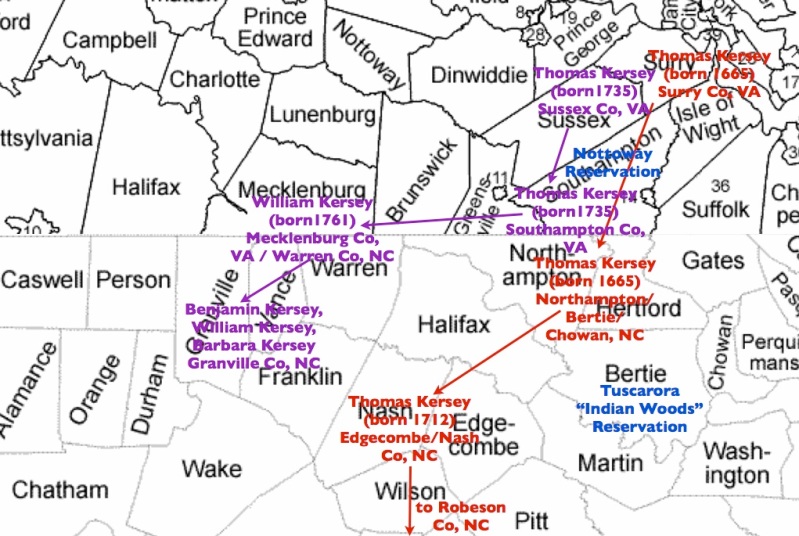
© Kianga Lucas
Granville County’s Kersey Lineage
So with the background information that Woods has provided about the Kersey-Weyanoke connections, let’s take a closer look at the genealogy of Granville’s Kersey family.
Identifying the precise verified earliest member for the Kersey family of Granville is a bit tricky, because Heinegg in his Kersey genealogy, leaves a lot of room for speculation. However I am comfortable saying that Thomas Kersey (born 1735) of Sussex and Southampton County, VA is the earliest verified ancestor. Heinegg suspects that Thomas Kersey is a descendant of John Kersey (born 1668) of Surry Co, VA. This John Kersey is probably a brother of previously mentioned Thomas Kersey (born 1665) of Surry Co, VA who was the subject of Cedric Woods’ essay. I agree that Thomas Kersey (born 1735) descends from the Kerseys next door in Surry Co, but more research is needed to correctly identify his parents. Because there are several different related Thomas Kerseys found in these early records, Heinegg has unfortunately incorrectly attributed records to the wrong Kersey, so below is a corrected version of major life events for Thomas Kersey (born 1735).
Thomas Kersey (born 1735)
The first verified record for Thomas Kersey (born 1735) is when he was sued for debt by David Wiggins in Sussex Co, VA court in 1755. (Sussex Co was formed from Surry Co in 1749). The following year in 1756, Thomas received a plat for 104 acres of land on the southside of the Nottoway River near Ploughman Swamp in Sussex Co. This is in close proximity of the former Nottoway and Weyanoke village called “Warekeck” that was located in the Blackwater River area that Woods describes in his essay. Thomas Kersey then sold this land in 1759 to William Longbottom. Next, Thomas Kersey purchased land in neighboring Southampton Co, VA in 1760 from the previously mentioned David and Elizabeth Wiggins who were residents of Surry Co, VA. This land was situated on Three Creeks and was adjacent to Thomas Wiggins and McLemore (probably a descendant of James McLemore, a Scottish born settler). This Southampton County land owned by Thomas Kersey was also adjacent to the bounded Nottoway “square tract” reservation.
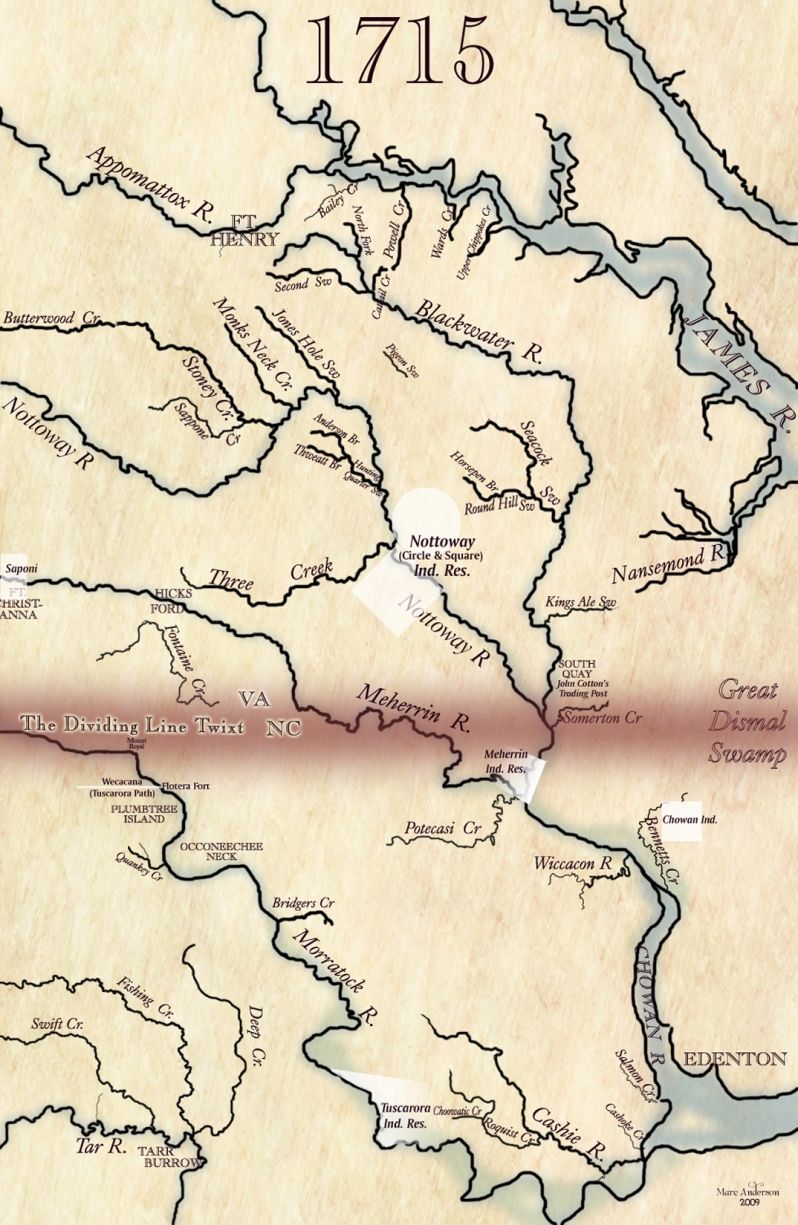
Source: https://andersonnc.wordpress.com/2-john-pitmans-of-iow/
Thomas Kersey’s wife is unknown but I have strong reason to believe she was from the Native American/”free colored” Walden family of Southampton County. Thomas did not leave a will, but the Kerseys who appear in the subsequent Southampton records, are most likely his children. These children include: William Kersey (born 1761), Agatha Kersey (born 1762), Thomas Kersey (born 1767), Walden Kersey (born 1767), Willis Kersey, Delilah Kersey (born 1778), and Loudon Kersey.
Walden Kersey’s name is very revealing because it was common practice for the maiden names of wives to be passed down as first names in their descendants. The Walden family is also ancestral to many Native American families of Granville County (myself included). The Waldens are connected to the Nottoway and there are still Walden descendants among the state recognized Nottoway Tribe of Southampton County. This is why I strongly believe that Thomas Kersey’s (born 1735) wife was a Walden.
William Kersey (born 1761)
From here we turn to Thomas Kersey’s son William Kersey (born 1761). William was a tithable in Southampton County, VA in 1780. In 1786, he married Polly Evans, the daughter of Thomas Evans (1723-1788) and his unnamed Walden wife of Mecklenburg County, VA. Polly Evans was the sister of my 5th great-grandmother Margaret Evans and I discussed their Evans family here. After marrying Polly Evans, William Kersey appears in both Southampton and Mecklenburg records, but Mecklenburg County appears to be his primary residence. This Mecklenburg County property was situated right on the Warren County, NC border because William Kersey was recorded just as frequently in the Warren County records.
In 1832, William Kersey filed a pension for his services in the Revolutionary War. You can find excerpts of his pension application here. From this application we learn many details of his war service. He first enlisted in 1777, survived the disastrous winter camp at Valley Forge, and fought in the Battle of Monmouth. Other important details in the pension application confirm that William Kersey was from Southampton County but moved to Warren County towards the end of the war and continued to live there through to the present because he received 640 acres of land for his war service. William Chavis (not the founder of Granville’s Native American community) provided testimony in support of William Kersey’s pension and stated that he remembered William Kersey’s wedding to Polly Evans because there was lots of “fiddling and dancing”, and the wedding took place at Polly’s father Thomas Evans’ home. From the pension records, we learn that William Kersey later died in 1836 and that his widow Polly (Evans) Kersey died in 1840.
In 1845, William and Polly Kersey’s youngest son Edmund Kersey (born 1805), sought to collect his father’s pension payments and listed the names of William and Polly’s other surviving children. In addition to Edmund, the other surviving children named were: Thomas Kersey (born 1785), William Kersey (born 1794), Nancy Kersey (born 1799) and Barbara Kersey (born 1800). One son was not named and that was Benjamin Kersey (1790-1838). Thomas Kersey (born 1785) and Nancy Kersey (born 1799) remained on the Mecklenburg County side of the border, and Edmund Kersey (born 1805) remained on the Warren County side of the border. However Benjamin Kersey (1790-1838), William Kersey (born 1794), and Barbara Kersey (born 1800) had all moved to Granville County by 1830. William Kersey was married to Margaret Ivey and moved further into North Carolina and settled in Orange County. Barbara Kersey was married to Martin Anderson of the Native American/”free colored” Anderson family. Benjamin Kersey was married to a woman named Sally (maiden name not known). However Benjamin died by 1838, and his widow Sally remarried Martin Anderson who had been widowed when his first wife Barbara Kersey died.
Benjamin Kersey (1790-1838)
As stated earlier, Benjamin Kersey (1790-1838) was not named as a surviving child in William Kersey’s pension record because Benjamin died in 1838, 7 years before Edmund Kersey petitioned to collect their father’s pension payments. And because Benjamin’s widow Sally had remarried Martin Anderson, she was not entitled to any support from William Kersey’s pension. All of Benjamin Kersey’s children and grandchildren intermarried with members of Granville’s Native American community including: Tyler, Anderson, Howell, Harris, Chavis, and Richardson families and continued to live in the heart of the community.
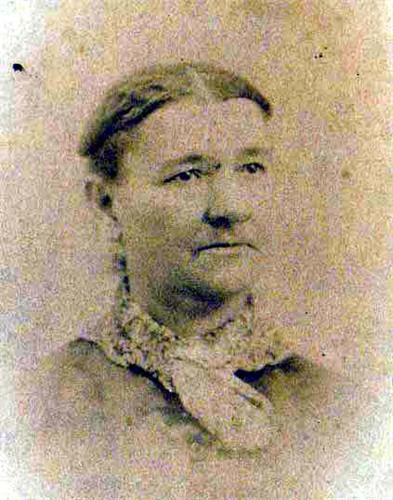
Source: Ancestry, Username: wanhiehol
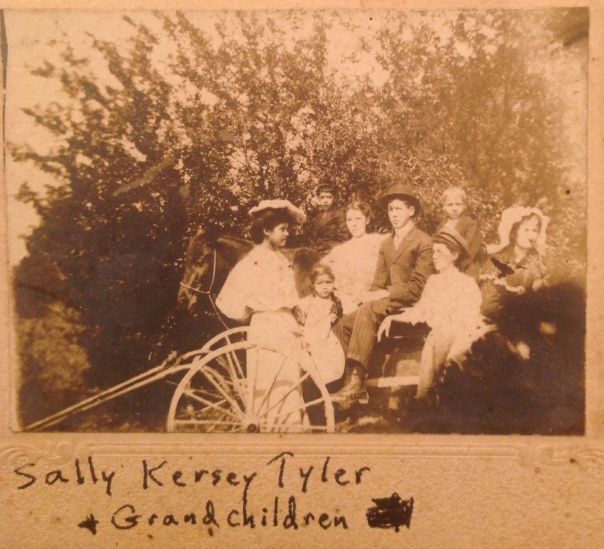
The Adventurous Life of Baldy Kersey (1820-1899)
Baldy Kersey (1820-1899) was a son of Benjamin and Sally Kersey and was a well known person in Granville County whose name made the papers for being on the wrong side of the law. Baldy Kersey was first married to Frances Tyler and they adopted the four children of Frances Tyler’s sister Martha Tyler (their adopted daughter Betsy Ann Tyler was the first wife of my 2nd great-grandfather James E. Howell). In 1864, Baldy Kersey escaped from jail in Oxford and the following notice was published which includes a physical description of him:
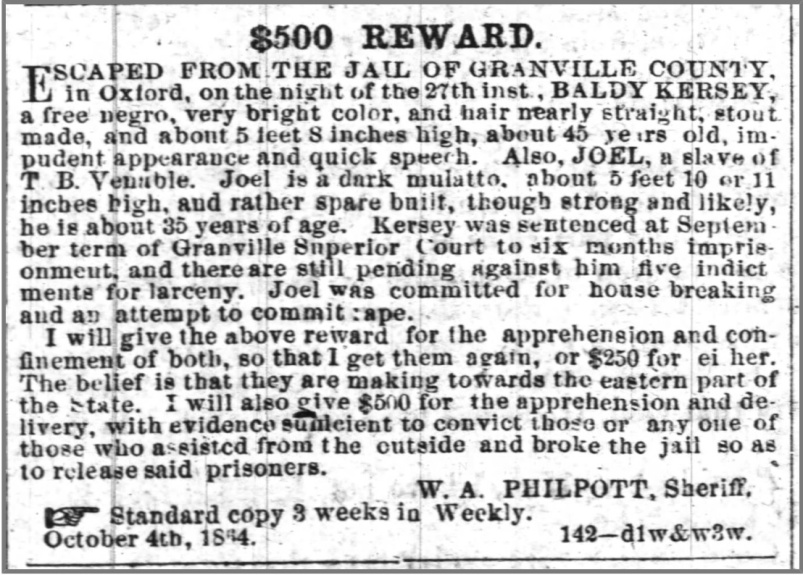
In 1866 as recorded in the Freedmen’s Bureau records, Baldy Kersey was again accused of larceny when he stole a horse and a mule and sold them to Avery Taborn, another member of the community.
In 1880, Baldy Kersey was arrested along with a white man named John Smith. They were accused of being in charge of a gang that was stealing horses and counterfeiting:
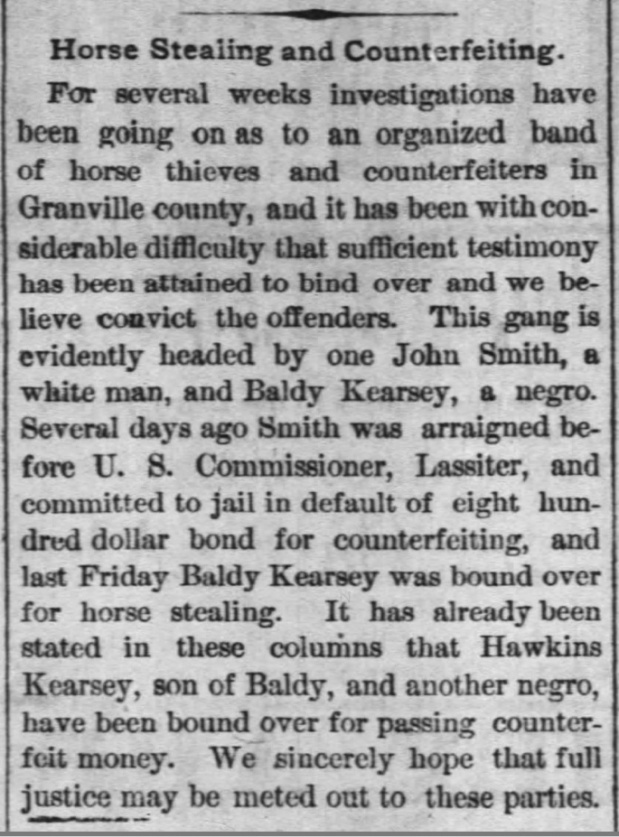
Baldy Kersey was also involved in a famous land case that went up all the way up to the United States Supreme Court. Apparently, a man named Col. Edwards was attempting to collect a debt from Baldy Kersey, and Baldy claimed his homestead. Baldy Kersey’s land was in the heart of the Native American community in Granville County, in Fishing Creek township and it was very important for Baldy to hold onto this land. As you’ll recall from earlier, Baldy’s mother Sally (maiden name unknown) remarried Martin Anderson after her husband Benjamin Kersey died. In order to keep this highly valued land in the family, Sally Anderson paid Baldy’s debt and put the land deed in her name. Perhaps to stop her other children (and debtors) from claiming the land, Sally Anderson disinherited her children and left the land solely to Baldy in her will. However after her death, her will was being contested on the grounds of insanity.
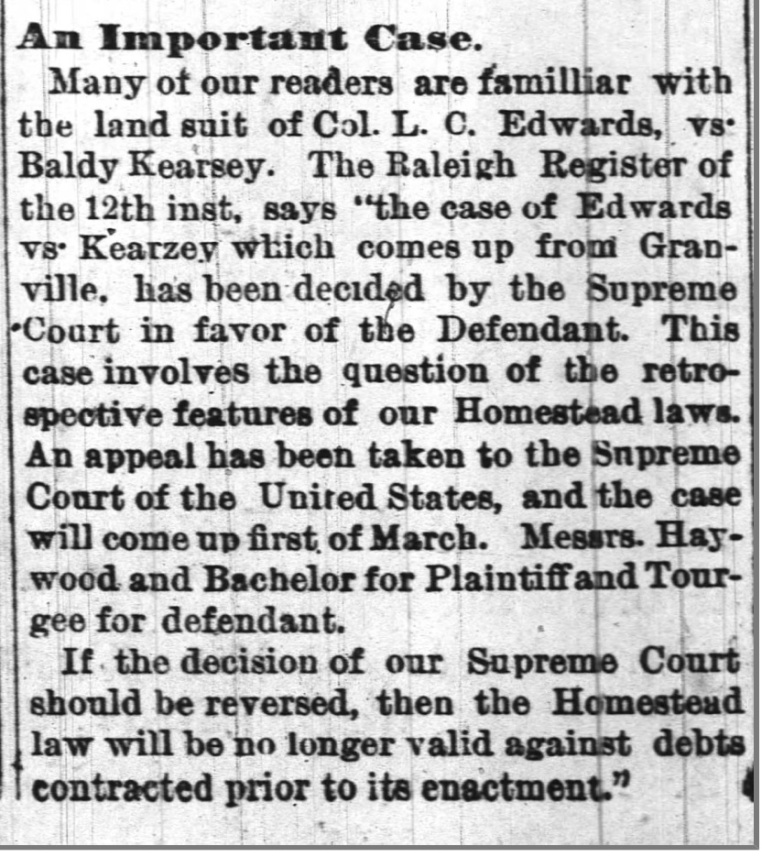
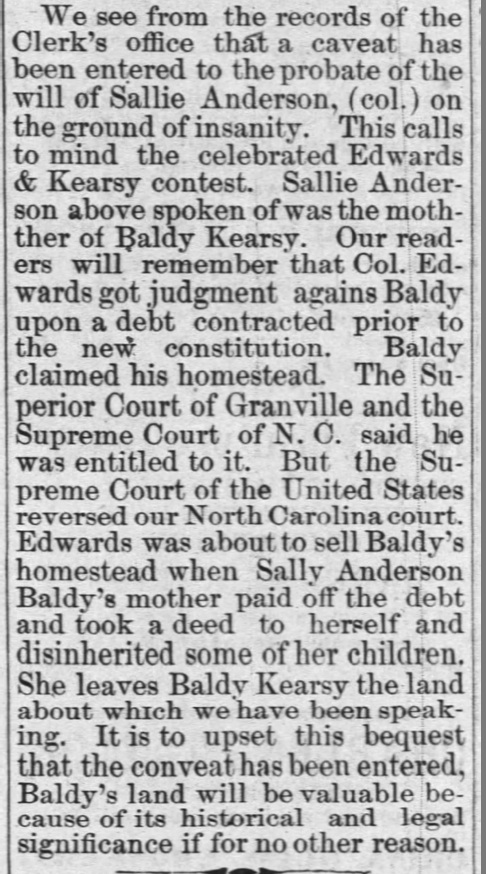
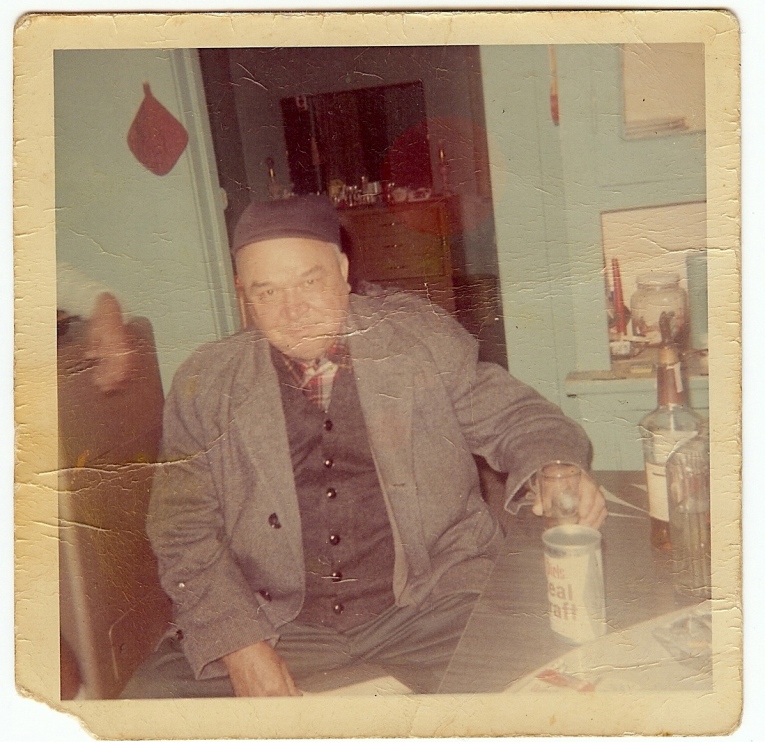
Source: Darrin Norwood
So to summarize, the Kersey family came to Granville County in the early 1800s, after the founding members had already established a Native American community. Previous to Granville County, the Kersey’s tribal origins are with the Algonquian speaking Weyanoke tribe who sought refuge and intermarried with the Iroquois speaking Nottoway and Tuscarora tribes. The Kersey lineage that came to Granville, was more closely connected to the Nottoway tribe because of intermarriage with the Nottoway Walden family. The journey of the Kersey family exemplifies how early contact Native American peoples maintained their Native identity in spite of colonial pressures to relocate.

Reblogged this on Anishinaabek Windwriter.
LikeLiked by 1 person
Has anyone researched a David and Agnes Kersey orgins may have lived in North Carolina. Their descendants moved to Wilkes and Elbert county Georgia circa 1800
LikeLike
Kudos, to cousin Kianga, for she is driven to dig deep for the records; data, migrations, deeds, leans, marriages, bonds etc. I thoroughly enjoy reading her blogs because of the enlightenment she provides via her works. I am all about trying to connect the dots as well. But, I am but a novice compared. Anyway, I just wanted to add that I’m “Walden” descending from both of my biological parents. The Walden ancestry is one that is seeming recorded with more accuracy than any other in my ancestry thus far, that I laid eyes on except the “Guy” ancestry perhaps. My sire’s great grandmother is Easter/Esther Walden b, about.1850 & married Joseph Scott, b. about 1842. in SE Northampton Co. NC. My mother’s great grandmother was Elizabeth Francis Jones -Walden b 1856 & married William Walden #IV b. about 1837.And, one of their daughters a Elizabeth “Bettie Sue” Walden b. about 1870 is my mother’s grandmother. This Elizabeth Walden b.about 1870, then married a John Henry Coleman Guy b. about 1860 in Mecklenburg Co. Virginia & died in Northampton Co. NC 1944. So, I descend from “Walden” on both sides of my genealogy. I always wondered why my legs were so bow & ppl teased me about my bow-legs & I was once ashamed of my very strong defined bow legs. I embrace them now as I became enlightened that this trait probably was inherited from my Native/Indigenous ancestors. I could run very fast & jump very high. Again, Thanks to my double cousin Kianga Lucas!
LikeLike
Well, I thoroughly enjoyed & consumed this Op-Ed of our VA/NC Ancestral origins. Interesting for me is a fact that I descend from a long line of “Walden” ancestors hailing out of Surry County Virginia and possibly other nearby counties in VA. My great grandmother was Elizabeth “Betty Sue” Jones Walden b. abt 1873 & she was the daughter of William6 Walden & Elizabeth Jones. Then, my maternal great grandmother married and procreated with a gentleman who hailed out of nearby Mecklenburg County, Virginia another VA/NC state bordering county. His name was John Henry Coleman Guy b. abt 1859 to a Lucinda “Puss” Guy. We assume his father was a close relative to “Puss” possible a Coleman or another Guy relative in the community. Anyway, John HC Guy married Elizabeth Jones Frances Walden & they procreated ten off springs who lived originally in the so called “Cumbo Community” or the legally titled” Roanoke District” right off the Roaring Roanoke River in the central part of Northampton County, NC. near the townships of Rehobeth, Lasker, Jackson & Rich Square, NC. Their off-springs were 1. (Twins- John & James Guy) 2. Willis Guy 3. Geneva Guy 4.Virginia “Brighty” Guy m. Elias Pope 5. Ola Mae “Sweetie Guy” m. Mr. Artis & then Mr. Willie Mitchell. 6. My great granny ( Alice Saluda Guy b. 1895 & married Richard Henry Ramsey- Moore 7. Raymond P. Guy b. 1893 8. Tiny “Sis” Guy 9. Gladys Guy, married Cader Manley. Now, getting deeper in my ancestry. My paternal ancestral lines descend allegedly from the Chowanoke, Meherrin, Tuscarora, Nottoway Native People. My gg granny is a Polly Hicks Martin Canada- Manley b. abt 1873 in one of the NC/VA border counties…Perhaps Hertford NC of Southampton Co VA. Another gg grand mother is Rebecca Scott b. abt 1865 in Northampton Co. NC & is the daughter of Joe Scott & Easter/Esther Walden. Joe Scott is alleged to have come from Edgecombe or Halifax across the Roanoke River. Thus, I have two gg grandmothers that are “Walden” siblings it seems. Our/my amazing heritage is a very rich culmination/amalgamation of these “free colored” native indigenous people of the NC/VA borders. And, perhaps tracing further back into the migrations…Maryland, Pennsylvania & other East Coast Territories are of interest. I do have a “Brick Wall” blocking/concealing the origins a gg grandfather…William Henry Harvey b. abt
1850 in possibly a nearby VA/NC county. He shows up in Rich Square Community abt .1886 abt 36 yrs of age as a carpenter/roofer. He soon falls in love and marries one of Joe Scott & Easter/Esther Walden-Scott daughters…a Rebecca Scott Walden b. abt 1865. They procreated (Ten Harvey- Walden- Scott off-springs in the Ashe Town, Bryant Town, Boone Town & Cumbo communities) on the out skirts of R. Square Northampton Co. NC. No, other( Harvey) surnames in the whole Northampton County, NC other than this particular set. We know (William Henry Harvey) stated he was born March 1850 & he was a very tall 6’4″ man, brown/red skin with wavy curly dark brown hair. And, that is all we have thus far on him. No parents, siblings or cousins known. Mysterious…Yes!
LikeLike
Have you made the connection between your Waldens and the Goins-Walden Cemetary at Fort Bragg? I’m related to both families on my maternal side. Thanks for sharing your research.
LikeLiked by 1 person
Hello,
I am a Kersey from Windsor Ontario Canada. I can only trace my roots back to my great-grandfather who was born in Harrow Ontario in 1885 (free slaved settlement). Family legend states that the name was acquired through intermarriage with Quakers in Ohio/ Pensylvania area. Others state that the name originated in Virginia. Would the writer have a way of assisting me in researching American lineage connected to my heritage?
LikeLiked by 1 person
Found out I am a descendant of Baldy Kersey a while ago but just got back into doing my family tree. He is said to be my second great grandfather on my father’s side. I didn’t know much information on that side beyond his mother and father’s name and they were from Oxford, NC while my mother’s side is from Wilson, NC. So I love that I’m able to read this far back into history. And Sam is also my great grand uncle. I love all the information here that I am able to come back and read to help me build my family tree further. Thank you
LikeLiked by 1 person
Ted Kersey just out side oxford, nc I’m in henderson
LikeLike